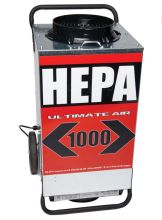
General / Basic Mold Remediation
Mold should only be removed by a trained (RIA, IAQA, IICRC) professional. These instructions are for small area remediation. Remember, in numerous states, licensing is required for either mold remediation or applying disinfectants for mold. Be sure to have employees fully protected, including Tyvek suits, boots, full-face respirators or partial respirators with goggles, hard hats, and rubber gloves with cloth work gloves over them (this makes it easier to work with tools).
Directions:
- Determine the size of the area that will need to be contained. Set up your containment using Zipwalls and 6-mil poly sheeting.
- Determine size of air scrubber needed (4-6 air exchanges per hour).
- Install air scrubber into containment, duct clean air from the scrubber out of the containment area to keep the containment under negative pressure.
- Vacuum all surfaces in the containment area using a HEPA vacuum.
- Remove all porous surfaces (drywall, carpet, etc.) with mold contamination. The material that is being removed should be placed in contractor bags and disposed of in normal garbage receptacles (e.g., dumpsters). Bags should be sealed before leaving the containment area.
- Vacuum all surfaces in the containment area using a HEPA vacuum.
- Physical mold removal:
- Using a cleaner, all surfaces with visible mold should be scrubbed or sanded to remove some of the mold staining. Without heavy sanding, some of these stains might not be removed. Staining is not an indication of active mold growth.
- Using a disinfectant, wipe or spray all surfaces to ensure any remaining (hidden) mold is dead. This will not preclude any health problems from the mold, but it will keep it from further growth.
- Again, vacuum all surfaces in the containment area using a HEPA vacuum.
- A mold-preventative coating can/may be applied to further ensure no future mold growth.
- For larger jobs (over 32 sq ft of contamination) it may be required to:
- Have a controlled egress area.
- Have an independent hygienist write a protocol.
- Have an independent hygienist do post clearance testing.


We pay the shipping charge, including hazardous material fees, on this item. There's no catch. No "buy this to get that" requirement.
Note: If your order contains items that are not eligible for free shipping, your order total will include our competitive shipping rates for those non-eligible items only. This shipping policy only applies to orders shipped within the Contiguous U.S.

